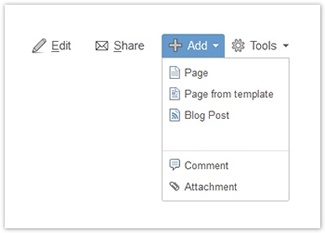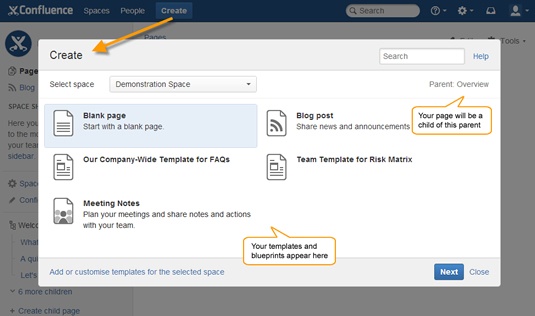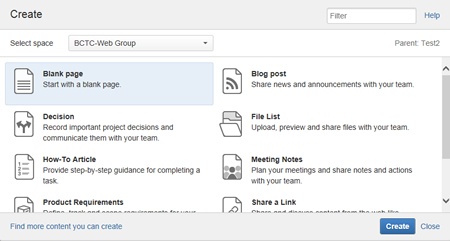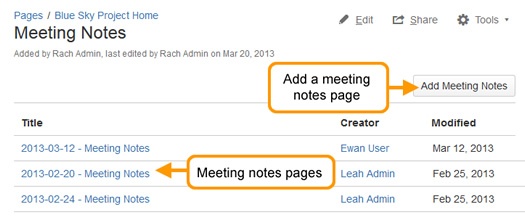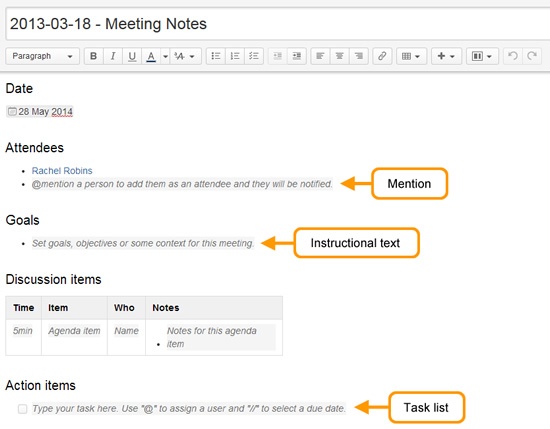...
| Section |
|---|
Confluence 5 Upgrade - ChangesRedesigned HeaderThe Confluence header has been updated and consolidates a number of options into one location:
Creating ContentThe 'Add' option has disappeared from the top of pages and from the dashboard. Instead, Confluence 5 offers a Create option in the Confluence header. Previously: 'Add' button on page
'Create' in the Confluence header, for creating a page or blog post More View more information on creating a new page can be found further below. |
Wiki and Confluence Overview
...
Complete Confluence User Guides
- Complete Confluence User GuidePDF version (PDF)
- Confluence Quick Start of the complete Confluence User Guide
Common Tasks in Confluence
...
- Select 'Create' in the Confluence header, as shown above
- Select the Space in which the page will reside
- Choose the type of page to create - Blank page is the default
- Select the 'Create' button on the bottom of the dialog box
- By default, Confluence will add the new page as a child of the page you are viewing. View the "breadcrumbs" under the Confluence header for your page location. If you need to move the page to a different space or a different parent, you can edit the page location by selecting 'Location' at the bottom of the page.
- Enter a name (title) for your page. This is how it will be referred to from other pages.
- Enter content for your page and style it using the Rich Text editor box below the title.
- Select 'Preview' to preview the page before saving it.
- Select 'Save' to save the page
...
- From the page and location you wish to link from, click on the 'Link' button on the toolbar (the one that has two chain links). A pop-up screen will appear.
- In the pop-up screen, click on the tab labeled "AttachmentsFiles" To add a new attachmentfile, click on the "Choose File" button to get to files on your computer, and select the appropriate file.
- After selecting the file, it will automatically upload and show up in the list of attachments on the same screen. This is a list of all the attachments to that particular page.
- Select the attachment you just uploaded from the list and in the field called Change the "Link Text" enter the words you wish to appear to represent the link on the actual page. For instance, you might type "click here to see our latest report". The link can appear in the middle of a paragraph, and may simply be part of a sentence.
- Another way to enter the words that will form the link is to highlight the words in the edit window before clicking the 'Link' button. These words will automatically appear in the "Link Text" field and all you have to do is add the attachment info.
- When ready, click the "Insert" button at the bottom of the pop-up screen.
Adding an Attachment to a Page for Future Linking
- Go to a page in the space, open the 'Tools' menu and select 'Attachments'. The 'Attachments' view will open.
- Click the 'Choose File' button.
- Browse through your files and select the file you'd like to attach.
- Enter a description for the attachment in the 'Comment' text field (optional).
- Click 'Attach more files' if required.
- Click 'Attach'.
- if needed
- When ready, click the "Insert" button at the bottom of the pop-up screen.
Quick instructions: Choose "Link" Button > Choose Files > Click Choose file (to select a files) > Then update the link text as needed > Click insert
Adding an Attachment to a Page for Future Linking
- Go to a page in the space, open the 'Tools' menu and select 'Attachments'. The 'Attachments' view will open.
- Click the 'Choose File' button.
- Browse through your files and select the file you'd like to attach.
- Enter a description for the attachment in the 'Comment' text field (optional).
- Click 'Attach more files' if required.
- Click 'Attach'.
Once you attach a file, you can then provide a link to it from a Confluence Once you attach a file, you can then provide a link to it from a Confluence page (see linking below). When a user clicks on the link, the attachment will open, so long as the user has the software application needed to open the attachment. In the case of image attachments, Confluence allows you to display attached images on the page.
...
| Warning |
|---|
Warning - Deleted comments cannot be restored. |
Linking ( Hyperlink)
You can create links to anywhere within Confluence (pages, news items, comments, attachments) or an external web site.
...
- Click the 'Tools' link at the top of the page and then click "Restrictions" or click "Edit" and then "Unrestricted" or "Restricted" at the lower left corner of the editor.
- A pop-up will appear allowing you to edit the restrictions. Select 'Restrict editing of this page'.
- Choose the appropriate user(s) and/or group(s) that you want to allow to edit the page, as described for 'viewing' restrictions above. Click the 'Save' link at the bottom of the page.
- editing of this page'.
- Choose the appropriate user(s) and/or group(s) that you want to allow to edit the page, as described for 'viewing' restrictions above.
- Click the 'Save' link at the bottom of the page.
Working with the Meeting Notes Blueprint
The Meeting Notes blueprint helps you to plan your meetings and share notes and actions with your team.
The first time you use the Meeting Notes blueprint in a space, Confluence will create an index page and add a shortcut on your space sidebar (if you are using the default theme). The index page lists the latest Meeting Notes pages in that space.
Screenshot: Index showing three Meeting Notes pages.
To use the Meeting Notes blueprint:
- Create a Meeting Notes blueprint page (choose Create > Meeting Notes).
- Enter goals, agenda items, @mention attendees - the instructional text will prompt you.
- Save your page and get ready to attend your meeting.
- During or after your meeting edit the page and enter your notes, action items and @mention users to assign them to tasks.
Screenshot: A blank Meeting Notes page showing instructional text.
Working with Tasks
Using a task list with the ability to give each task an assignee and due date, helps you to keep track of things that need to get done.
To create a task:
- In the editor choose the Task list button
- Start typing your task:
- use @ to assign the task to someone - the first person you mention in a task is the assignee
- use // to choose a due date (dd/mm/yyyy)
Example: @ John Paul contact each vendor for their product description 18 Nov 2014 –
John Paul has been assigned the task of getting the product information from the vendors by Nov 18, 2014.
You can mention more people in the task, but the first person mentioned will be the assignee - you can assign tasks to yourself also.
There are a number of ways to keep track of tasks assigned to you, or tasks you've created for others.
On a page
The simplest way to see a task is on the page it was originally created on, for example the Action items in a meeting notes page.
It is easy to see if a task is complete, who it is assigned to, and when it is due. If a task is nearing, or has passed its due date, the color of the date will change (red for overdue, orange for due in the next 7 days).
Screenshot: Tasks created on a meetings notes page
In your profile
The tasks page in your profile gives you a place to see all the tasks relevant to you in one place. Easily keep track of the status of tasks assigned to you, and tasks you've created and assigned to others.
To view the tasks page, go to Profile > Tasks.
Use the filters to show tasks that were assigned to you or created by you and toggle between complete or incomplete tasks.
Screenshot: Task page - Incomplete tasks assigned to me (Sophie)
In a Task Report
If you're looking for a more custom view of tasks, the Task Report blueprint is a great way to track tasks assigned to a specific team or project.
To create a task report:
- Choose Create > Task Report
- Select the type of report:
- Assigned to my team for tasks assigned to particular people
- In my project for tasks that appear in a specific space or page, or
- Custom for a wide range of filtering options, including by date or page label.
- Follow the prompts to create the report.
This blueprint uses the Task Report macro. You can also choose to use this macro on an existing page, for example, on a project or team space homepage.
Screenshot: Task Report for a particular month
Working with News/Blogs
Each space in Confluence can publish its own news. News items may be announcements, journal entries, status reports or any other timely information you would categorize as 'news' pertaining to a space. News items are also known as 'blog posts'.
...
- Go to your name at the top of the page. (This is the 'User' menu. A dropdown list will appear when your cursor hovers over the 'User' menu.) Select 'Settings' from the dropdown drop down list. The 'Settings' view will open.
- Click the 'Email' link in the left-hand panel.
- Click the 'Edit' button.
- Check the box beside 'Subscribe to daily updates'.
- If you want to receive a notification each time you add or edit content on Confluence yourself, check the box beside 'Notify on my actions'. If you leave this box unchecked, you will receive notification of other people's actions but not of your own.
- Click 'Submit'.
...
Go to your name at the top of the page. (This is the 'User' menu. A dropdown list will appear when your cursor hovers over the 'User' menu.) Select 'Settings' from the dropdown list. The 'Settings' view will open.
Info Name and Email are not editable in your user profile. This information reflects the name and email on record in Active Directory
Confluence Screenshots, Atlassian, Source (https://confluence.atlassian.com/display/DOC/), CC 2.5

